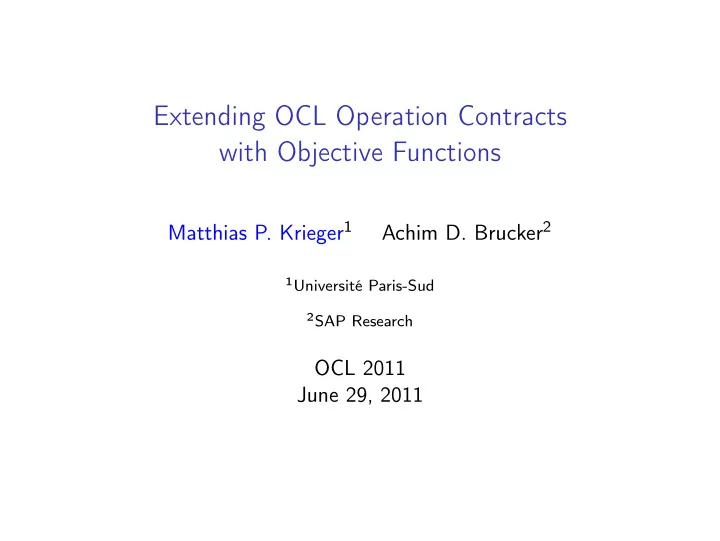

Extending OCL Operation Contracts with Objective Functions Matthias P. Krieger 1 Achim D. Brucker 2 1 Université Paris-Sud 2 SAP Research OCL 2011 June 29, 2011
Outline Introduction Applications of Objective Functions Tool Support 2 / 11
OCL Has Some Limitations ◮ OCL expressions can usually be evaluated (relatively) efficiently ◮ OCL does not have: ◮ Powerset operation ◮ Unbounded quantifiers ◮ ... + Useful tool support is achievable – Some things are hard to specify in OCL ◮ Optimization: Result is “at least as good as” all possible results Often difficult to specify in a postcondition 3 / 11
Easier Specification of Optimization Problems Idea : preserve OCL expression language Extend operation contracts with objective functions context Graph : : vertexCover ( ) : Set ( Vertex ) post : v e r t i c e s − >i n c l u d e s A l l ( r e s u l t ) post : r e s u l t − >c o l l e c t ( i n c i d e n t ) = edges minimize : r e s u l t − >s i z e () For existing applications of OCL, objective functions can be ignored. 4 / 11
Optimization Problems are Everywhere Optimization problems covered in Sedgewick, Algorithms : ◮ Closest pair among a set of points ◮ Minimum spanning tree of a graph ◮ Shortest path in a graph ◮ Maximum network flow ◮ Maximum matching of a graph ◮ Regression: Least Squares ◮ Knapsack problem ◮ Linear programming 5 / 11
Objective Functions are Even More Useful Further application : Problems that do not always have a solution context C : : op ( ) : T pre : P post : Q What if the postcondition Q may be unsatisfiable even if the precondition P is true? context C : : op ( ) : T pre : P post : not r e s u l t . o c l I s U n d e f i n e d () implies Q minimize : i f r e s u l t . o c l I s U n d e f i n e d () then 1 else 0 endif 6 / 11
Example: Graph Search Return empty sequence if there is no path context Graph : : findPath ( s t a r t : Vertex , end : Vertex ) : Sequence ( Vertex ) post : r e s u l t − >notEmpty () implies r e s u l t − >at (1) = s t a r t and r e s u l t − >at ( r e s u l t − >s i z e ( ) ) = end post : Sequence { 1 . . r e s u l t − >s i z e () − 1} − > f o r A l l ( i | r e s u l t − >at ( i ) . adjacent − >i n c l u d e s ( r e s u l t − >at ( i +1))) minimize : i f r e s u l t − >isEmpty () then 1 else 0 endif 7 / 11
Tool Support: Animation of Operation Contracts Pre-state Operation arguments ⇓ Post-state Return value In essence: solving of constraints expressed by the postconditions 8 / 11
Objective Functions are Essential for Animation Usually only (quasi-) optimal results are useful Similar case: frame conditions UML profile with objective functions and frame conditions: (uml) Operation «stereotype» oclExec minimize: String [0..1] propertiesModified: Property [*] {ordered,unique} objectsModified: String [*] {ordered} 9 / 11
Animation with Objective Functions ◮ Even without objective functions, operation contract satisfiability is not decidable. ◮ If valid operation results exist, they can be found by systematic enumeration. ◮ With objective functions, satisfaction of operation contracts is undecidable. ◮ Optimality can sometimes be proved by incomplete methods. ◮ General solution: specify a timeout for animation 10 / 11
Conclusion ◮ Objective functions are useful ◮ for specifying optimization problems ◮ and more ◮ Painless extension via UML profile ◮ Tool support for animation available 11 / 11
Recommend
More recommend